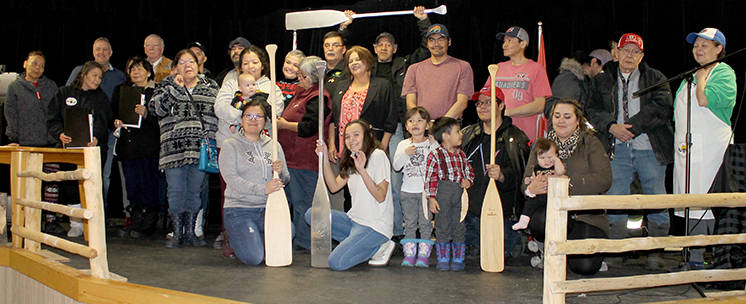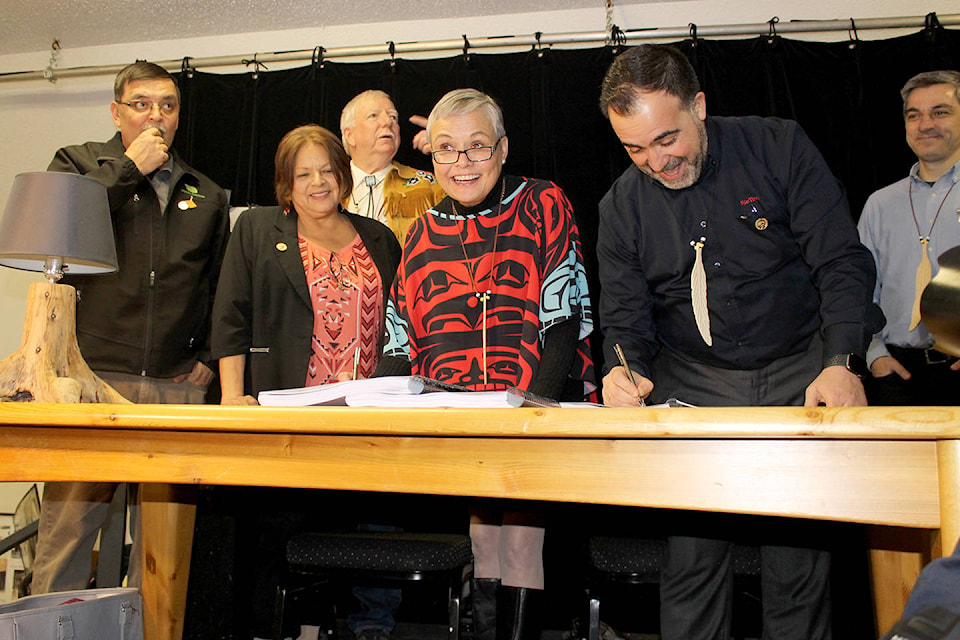Rio Tinto is enlisting the help of the Cheslatta Carrier Nation to ensure enough water remains in the Nechako Reservoir to generate electricity for its Kitimat aluminium smelter.
Cheslatta and Rio Tinto representatives met on Thursday, February 27, to sign the New Day Agreement, a long-term partnership to support the Cheslatta community and Rio Tinto’s hydroelectric operations in the Nechako watershed.
Rio Tinto Canada media relations director Simon Letendre said the agreement will focus on training, employment and business opportunities for the Cheslatta, as well as environmental stewardship.
“Measures include support for a remote training center built on Cheslatta property in 2018, which will deliver diverse trades, skills, safety, marine and driver training courses,” said Letendre.
Cheslatta students will also have access to scholarships, with Rio Tinto and the Cheslatta working to develop internships. Information will also be shared with Cheslatta members on job positions and procurement opportunities within the company’s hydroelectric operations, as well as on potential Cheslatta candidates and suppliers.
The agreement also provides for the creation of the Nechako Reservoir Stewardship Program, a joint initiative that will leverage local knowledge to maintain the Nechako Reservoir watershed ecosystem while promoting recreation and tourism opportunities.”
Rio Tinto BC Works in Kitimat relies on electricity generated at its hydro-electric plant at Kemano, about 80km from the town.
Water from the Nechako Reservoir, which stretches 230 km from its source to the water intake tunnel and covers a surface area of nearly 900 square kilometres, is channelled to the hydro-electric plant through an 18-kilometre tunnel bored through the mountains.
It is this hydro-electric power that ensures BC Works maintains its competitive edge on the world’s aluminium market, which Aluminium Association of Canada president and CEO Jean Simard said in January is forecast to experience a slowdown in the next decade in the face of stiff competition from China’s burgeoning aluminium industry.
It is also this hydro-electric power that is threatened by dropping levels in the Nechako Reservoir.
In an interview with Black Press in June last year, BC Works power, services and wharves operations director Andrew Czornohalan said while the risk of water surplus and water shortage is constantly managed, with decisions related to flood risk or drought risk mitigation occur many months in advance of any potential event, “risk levels can change quickly.”
“We are evaluating options and will take steps in 2019 to mitigate even lower levels in the spring next year, before the 2020 freshet,” said Czornohalan.
Between July 2018 and June 2019 levels in the reservoir dropped to the second-lowest since 1956.
READ MORE: Rio Tinto watching reservoir levels closely
“The total snowpack in the reservoir area was about 70 per cent of the average for the winter. Up until January 2019 it was quite typical then through February and March the levels were virtually flat.”
Recognizing the challenges facing the smelter as a result of low levels, Rio Tinto established the Water Engagement Initiative as a means of collaborating with First Nations, members of the public and governments in the Nechako region to ensure a balance between maintaining the Nechako Reservoir watershed ecosystem while promoting recreation and tourism opportunities.
Cheslatta Carrier Nation Chief Corrina Leween said the agreement is another step forward in restoring Cheslatta jurisdiction in their territory and implementing a stewardship initiative for the environment.
“I’m confident that this agreement will build and maintain a new relationship between the Cheslatta Carrier Nation and Rio Tinto based on the principles of reconciliation and partnership,” said Leween.
“Cheslatta businesses will have a preference for contracting and procurement opportunities with Rio Tinto. This will promote economic development in our community and build our capacity and confidence. The goal is to secure our self-sufficiency thereby ensuring that Cheslatta will never again be dependent on handouts.”
Rio Tinto Aluminium chief executive Alf Barrios said the agreement would ensure “long-term certainty between the Cheslatta Carrier Nation and Rio Tinto’s hydroelectric operations” in the watershed.
“We believe that working in partnership with Indigenous peoples is essential to achieve responsible and sustainable resource development that benefits us all,” said Barrios.
He said Rio Tinto and the Cheslatta have been engaged in a process of reconciliation for more than a decade, having returned 63 district lots totalling just over 11,000 acres of land to Cheslatta in 2012.
- with reporting from Aman Parhar

